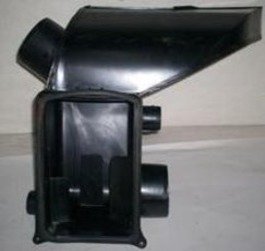
Often when faced with car AC airflow problems both professional and DIY car mechanics might think it’s a blower motor problem.
Although this is one of the possibilities there are several other common ones that can change the normal airflow from the air-conditioning or heater.
A big one is clogged cabin air filters. These filters require regular maintenance. What if the air is blowing, but in the wrong place.
One common complaint is when all the air comes out the defroster and hits the windshield first. On many cars this is the default selection made by the climate control system.
The job of the blend doors is to change the direction of flow and make sure that the air is discharged at the right location. Most cars have 3 areas to direct flow.
They use the feet location for heat, because hot air rises. This rising warmth will eventually evenly heat the whole interior cabin. The dash vents are used for AC. The third area is the defrost mode. Drivers can blend these functions. However, this will reduce total flow from the AC vents.
Two more doors to cover are the re-circulation door that closes the outside air intake and pulls air from the inside cabin. This is often called max ac, because its the best way to achieve the coldest output.
The temperature door is what decides if the air is directed through the ac evaporator or the heater core. Again, blending can provide a combination of the two. Drivers use the climate control center to control these blending operations.
The question is, what happens when the driver selects the temperature and direction of the air, but the results are different than expected. If the blower motor is running and no air comes out of the dash vents the problem can be a stuck or inoperative airflow control or blend door among other things.
Types of AC Airflow Controls
Back in the old days and still used on some vehicles is the simple cable operated slide blend control. In this case the driver physically pushes open or closed the doors via a cable and lever to achieve desired results.
Used on both newer and older vehicles is the popular vacuum operated blend doors.
This system uses the abundant engine vacuum to operate diaphragms that push or pull actuator rods. This will open or close the hinged flaps directing airflow into the proper ducts as selected by the driver.
The last type of control and most popular on modern automobiles would be the use of electrical motors that actually control the blend doors themselves.
In this case when the driver selects the desired temperature the climate control module sends a signal to a remote mounted electric motor that performs the adjustment on the fly.
Do you Have Car AC Airflow Problems
All three of the above systems mentioned are for the most part reliable. Although as these vehicles get older some common AC airflow problems may develop.
The most reliable of all of these would be the cable-operated system. Even the cable can experience problems such as binding or kinking that reduce the efficiency of the opening and closing of the blend doors.
Often when this occurs the driver feels a spring back on the temperature control as they try to operate it. When experiencing this problem inspection of the cable and possible replacement of the component will be needed.
Car AC airflow problems on vacuum operated systems usually stem from missing vacuum inputs. No vacuum signal can cause the air to dump behind the dash and flow very weak from all of the vents. When you hear the blower motor running and have weak or misdirected airflow checking the vacuum source is a good first step. Vacuum diagrams of air-conditioning system can be found in online car repair manuals.
The electric motor system first started to appear in the mid-90s on GM cars and trucks. Although this system works fantastic on modern vehicles it was not so reliable on the mid-90s vehicles.
An example of one of the most troublesome ones is pictured to the right. This is what the mid 90’s GM actuator motor looks like. Many of these electronic controlled actuator motor’s just plain failed.
When this happens the driver may not be able to control temperature or the direction of the airflow.
Since the diagnostic tree charts vary with the model, year and specific application it is recommended that you follow the diagnostic steps for your specific vehicle. In some cases, when you replace these AC airflow motors. They will have to be calibrated for proper operation.
The main lesson to learn is if you have car AC airflow problems and your blower motor is running your diagnosis should be heading for something that controls airflow not creates it.
Identifying what type of system you have first is important. It might be cable operated or have electrical motors or maybe the vacuum type. Knowing will lead you to the correct diagnostic steps.
Vehicles older then or around twenty years, deterioration of the rubber or foam sealing strips on the flap may be a problem and should be inspected. Give this car ac airflow problems page a bookmark or share with friends having a problem with their AC or automobiles heating systems.
Learn all about your automobiles air conditioning system on the main page for AC Systems. This next link takes you from car ac airflow to air-conditioning theory.
Learn more about the auto repair information available on this website on the homepage. Also find answers to auto repair questions.

